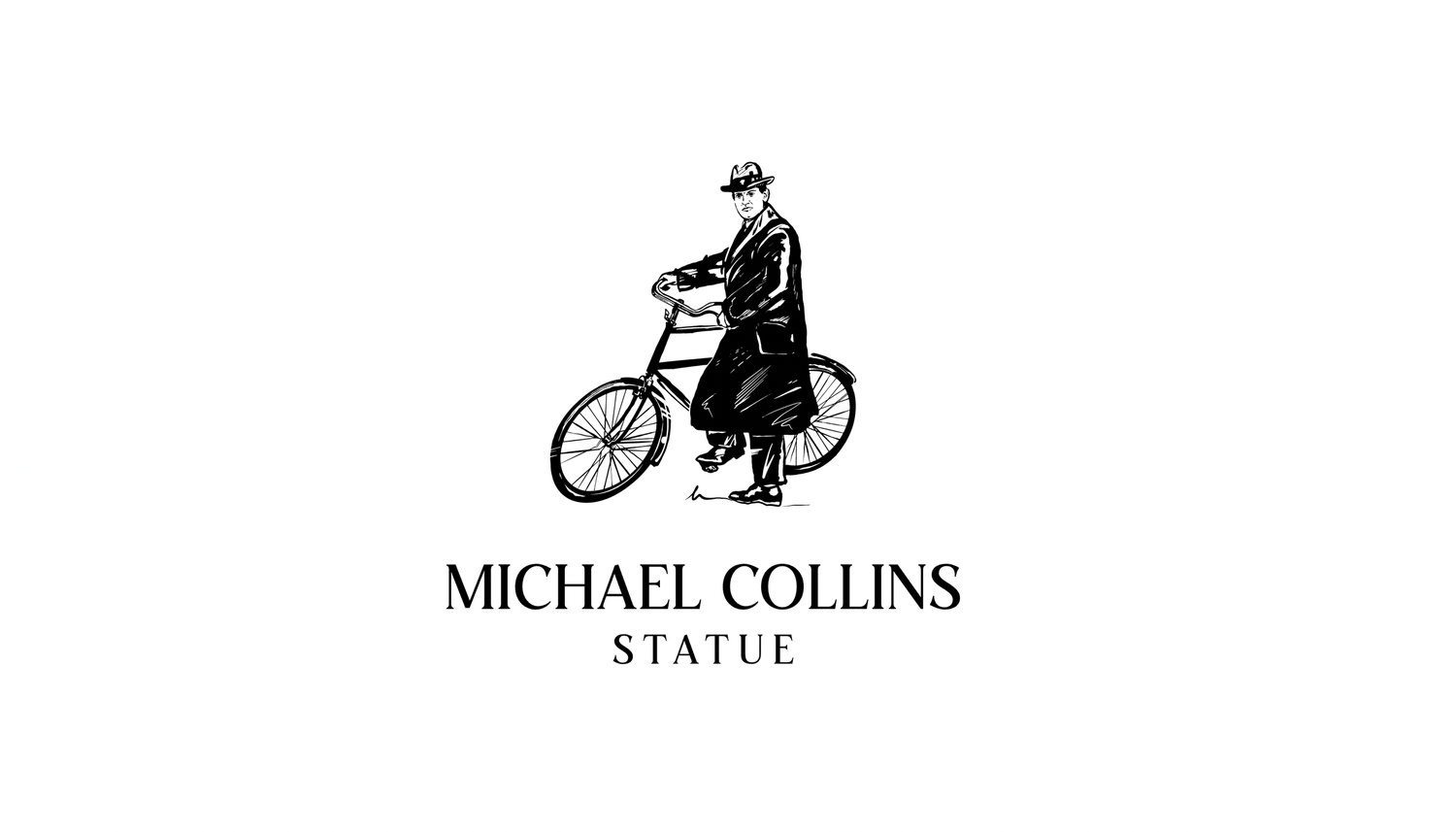Members of the Michael Collins 100 Committee have already lead a successful project to create the statue in Clonakilty.
In 2001, Cumann Seanchais Chloch na gCoillte (Clonakilty historical society) decided to erect a statue of Michael Collins in Clonakilty. A new committee was formed: the National Michael Collins Memorial Committee. An executive committee was also formed; it was responsible for bringing the project to fruition and comprised: Traolach Ó Donnabháin (Cumann Seanchais Chloch na gCoillte), Tim and Dolores Crowley (Michael Collins Centre, also members of Cumann Seanchais Chloch na gCoillte), Elizabeth O’Sullivan (grandniece of Michael Collins) and Tom Morrisey USA.
In 1919, Michael Collins, as Minster for Finance, launched the National Loan in front of Padraig Pearse’s school, St Enda’s, in Rathfarnham, in Dublin.23 The famous ceremony was filmed. On that occasion, Collins sat behind the oak block on which Robert Emmet was beheaded in 1803. To this day, that block is a potent symbol of Irish nationalism. In a silent film, Collins is seen sitting behind the execution block as the celebrities of the day provided him with contributions for the loan. He used the block as a table on which he signed the receipts.
In 2002, the National Michael Collins Memorial Committee launched the fundraising drive for the statue behind that same oak block; it was then housed at Kilmainham Gaol Museum, in Dublin. It was launched on February 2nd 2002 by historian and author Tim Pat Coogan. Among the dignitaries who attended the event was the then Taoiseach Bertie Ahern.
Artist Kevin Holland, based near Mallow in Co. Cork, was commissioned to make the Clonakilty statue. Shortly before that, Holland had completed the sculpture of the Ford Model T in the village of Ballinascarthy between Clonakilty and Bandon.
It was then time to choose the pose for the statue and to decide whether it should be dressed in military or civilian clothes. Collins spoke during an election meeting in Clonakilty on June 15th 1922, in front of O’Donovan’s Hotel. Silent-movie footage of this event shows Collins delivering his speech, during which he is seen tapping two fingers of his right hand off the palm of his left, evidently in an effort to emphasise a particular point. It was decided that due to this event occurring in Clonakilty and the fact that Collins mainly fought and worked in civilian clothes during the struggle for Irish Independence, the pose and clothing from that footage would be most appropriate for the statue. The size and stance were also agreed: it would be seven-foot tall and the statue would be stepping slightly off the pedestal.
Clonakilty Town Council agreed to donate a site for the statue in the town at the corner of Bridge Street (now Edward Twomey Street) and Emmet Square. This was a very appropriate location because Collins would have walked past that spot regularly while attending school in Clonakilty and stayed now and again in a house in the Square (then Shannon Square), rented by his sister Margaret.
Early on in the project, Clonakilty Town Council agreed to cover the cost of the site works. In addition, a grant of €22,000 was secured as part of the West Cork LEADER programme. The overall cost of the memorial project was over €100,000. The unveiling date was set for August 22nd 2002: the eightieth anniversary of Collins’ death. However, two months into the fundraising drive and with the unveiling date fast approaching, there was still a huge shortfall in funds
At that time, the executive committee had not yet secured a guest of honour to unveil the statue. At an early meeting, it was suggested that Irish actor Liam Neeson, who had played Michael Collins in the movie Michael Collins, should be invited. Naturally enough, the members of the committee believed that a big Hollywood star like Neeson would never travel to a little place like Clonakilty. Therefore, the suggestion was initially dismissed. Subsequently, as part of the fundraising initiative, Tim Crowley and Traolach Ó Donnabháin travelled to Castlebar in Co. Mayo, to deliver a lecture. By pure luck, they met a local auctioneer there called Tom Collins, who had become acquainted with Liam Neeson at the time of the filming of the movie.
Tom sent a fax on the committee’s behalf inviting Neeson to unveil the statue in Clonakilty. Two days later Neeson replied stating, “I would be honoured and privileged to unveil the statue of Michael Collins”.
This news changed everything. The celebrity factor kicked in! The national and international press – who up until then expressed little, or no, curiosity in the memorial project – suddenly developed huge interest. The increased publicity insured that the fundraising targets and unveiling deadline were met. It was also decided that there would be a weeklong festival leading up to the unveiling event.
When organising a large event, good luck plays a big part in its success. The committee were very fortunate on the day of the unveiling because everything went off like clockwork and the weather was glorious. The armoured car called Sliabh na mBan – which was part of Michael Collins’ convoy on the day of his fatal shooting – was set up a few meters from the statue. Gardaí present estimated that 7500 people attended the event. The atmosphere was electric! Liam Neeson received a tremendous welcome, and he told the audience that Michael Collins was his hero.
Most of the money raised to fund the memorial statue came from ordinary people, admirers of Michael Collins from all over the world. It can be stated, truly, that the statue in Clonakilty, like the memory of Michael Collins, belongs to the people.




